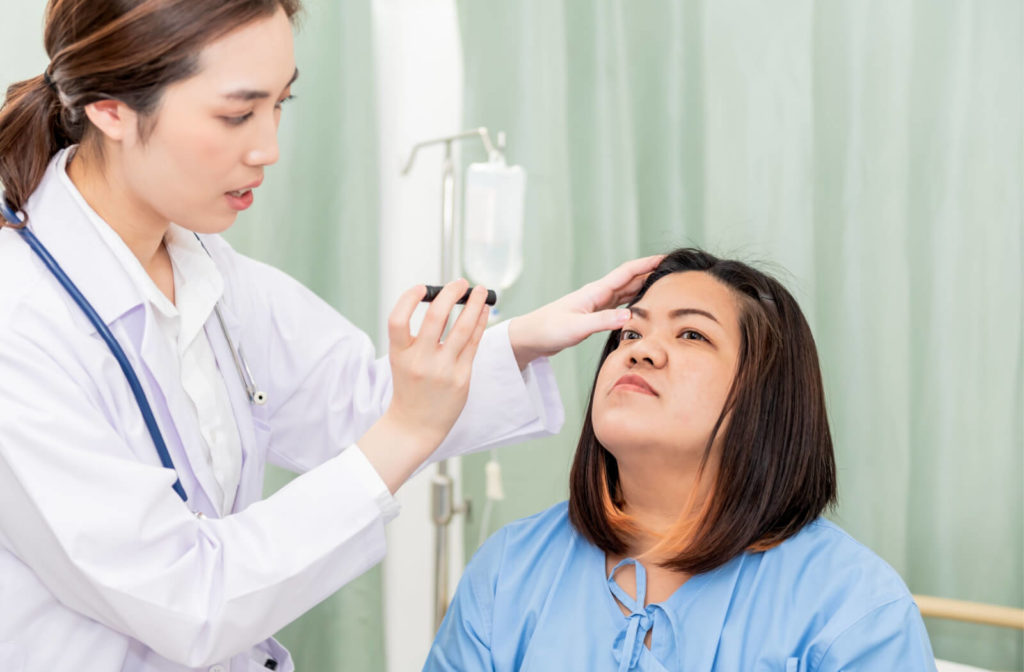Experiencing halos around lights at night can be caused by different things. Seeing halos can be jarring and annoying, but they can also be a sign of serious eye conditions or a side effect of laser vision correction. At their worst, they can be a symptom of a more serious eye and vision concern, like dry eye, cataracts, glaucoma, or corneal edema.
The first step in determining why you see halos is to schedule an eye exam with your eye care professional to get to the bottom of your vision concerns.
Let’s take a closer look at why you see halos around lights at night, including some of the different vision problems that can cause this.
Common Causes of Seeing Halos Around Lights
Seeing halos around lights, especially at night, can cause concern. Anything that alters your vision can leave you wondering if something is wrong.
Halos around lights could be a completely normal response to bright lights. However, a random appearance of halos accompanied by discomfort, blurred vision, and other symptoms can signify a more serious eye disorder.
Let’s explore some of these conditions and procedures that can cause you to see halos around lights at night.
Cataracts
Cataracts develop when the normally transparent lens of the eye becomes clouded. This clouding of the lens can affect your vision, and may include symptoms like:
- Seeing halos around lights
- Blurry vision
- Poor night vision
- Fading or yellowed colors
Cataracts are one of the leading causes of vision loss worldwide. In the early stages, your eye care professional can prescribe corrective lenses to help you see better. In later stages, when cataracts begin interfering with activities of daily living like reading or driving, cataract surgery can remove them to restore clear vision.
Dry Eyes
Dry eye disease occurs when your eyes don’t produce enough tears, or something has gone wrong with the tear-production process.
When the surface of your eye gets too dry, it can cause light entering the eye to scatter. This scattering of light can cause you to see halos around lights at night.
Some other symptoms of dry eye disease can include:
- Light sensitivity
- Blurred vision
- Eye Fatigue
- A burning sensation in the eyes
Glaucoma
Glaucoma is a group of eye diseases that progressively damage your optic nerve. The optic nerve is responsible for transporting information from your eyes to your brain, providing you with vision. This condition usually affects older age groups and, if left untreated, can lead to permanent vision loss.
Different types of glaucoma have different symptoms, and with acute angle-closure glaucoma, symptoms can include:
- Seeing halos around lights
- Eye pain
- Severe headaches
- Redness in the eyes
Acute angle-closure glaucoma is a medical emergency, and you should receive emergency eye care as soon as possible for treatment to help preserve your vision.
Corneal Edema
Corneal edema occurs when the cornea, the clear front surface of your eye, becomes swollen due to excess fluid accumulation. This swelling can be caused by various factors, including trauma, infections, or underlying eye conditions.
When the cornea swells, its normally clear surface can become cloudy or hazy, which disrupts the way light enters the eye. This disruption causes light to scatter, leading to the appearance of halos around lights, especially noticeable at night.
Some other symptoms of corneal edema can include:
- The feeling of having something in your eye
- Blurred vision
- Eye discomfort or pain
- Sensitivity to light
LASIK Eye Surgery
LASIK eye surgery may be surprising to see on this list, and it may not be here for the reasons you think. LASIK vision correction is a common eye procedure used to help correct refractive errors like myopia, hyperopia, and astigmatism.
During the LASIK process, your surgeon makes a small incision in the top layer of the cornea to create a thin flap. This thin flap is then folded back so your surgeon can access the corneal tissue and use a precision laser to shape your cornea to your prescription.
Following surgery, there is a recovery period, and you may experience side effects like seeing halos around lights. These halos usually only last for a few weeks following surgery, and your eye care professional can monitor your recovery during the post-surgery recovery period.

The Role of Environmental Factors and Seeing Halos Around Lights
Environmental factors can significantly influence the occurrence of halos around lights, particularly at night.
Low light conditions, such as driving at night, can exacerbate the visibility of halos. The contrast between bright headlights or streetlights and the surrounding darkness makes any visual distortions more noticeable. On top of low light conditions while driving, weather like fog, mist, or heavy rain can scatter light and create halos or glare, making it more challenging to see clearly.
Artificial lighting, such as the glare from digital screens, poorly designed streetlights, or oncoming headlights, can also contribute to seeing halos. The intensity and angle of these lights can cause discomfort and visual disturbances, especially if you have an underlying eye conditions.
Dust, smoke, or pollution, can scatter light and create visual effects similar to halos.
Understanding and managing these environmental influences, such as using anti-glare coatings on glasses or adjusting lighting conditions, can help reduce the occurrence of halos around lights at night.
Your Treatment & Prevention Options
Your treatment options depend on the underlying cause of why you’re seeing halos around lights. Your optometrist can help diagnose what’s going on with your eyes and vision through a comprehensive eye exam.
Following the exam, your eye doctor can prepare a personalized treatment plan to address issues like cataracts, glaucoma, and dry eyes.
It’s also important to consider prevention methods for eye disorders like cataracts and dry eyes. Some tips you can implement into your daily life include:
- Protecting your eyes from ultraviolet (UV) radiation by wearing protective sunglasses or lenses with UV protection
- Ensuring your diet is rich in vitamin C, vitamin A, and leafy green vegetables
- Maintaining a healthy lifestyle
- Avoiding excessive alcohol and smoking
Practicing prevention methods and getting the treatment recommended by your eye doctor can help maximize your eye health.
Taking Care of Your Eyes
It’s important to pay attention to the signs your eyes are giving you. If you start noticing halos around lights at night, visiting your optometrist for a comprehensive check-up at Seal Beach Eyes is always a good idea. Seeing halos around lights could be a normal response to bright lights or a sign of something more severe.




